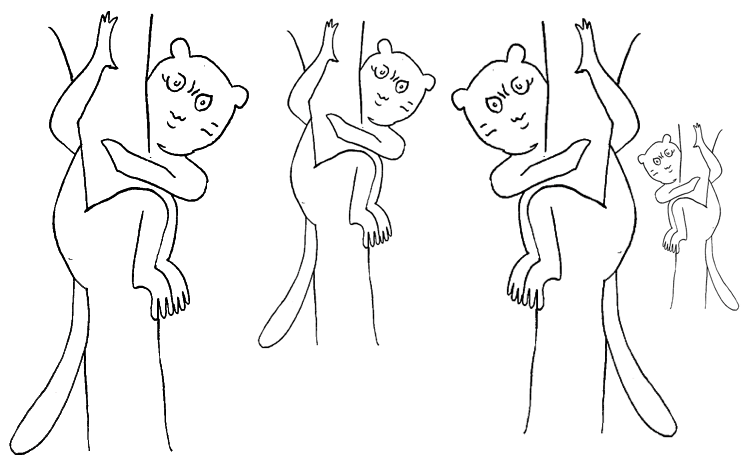


コーダ
Coda (music) 結尾部



☆ 音楽において、コーダ(イタリア語で「尾」、複数形はコード)は楽曲(または楽章)を終わらせる部分である。数小節程度のシンプルな場合もあれば、楽章全 体にわたる複雑な場合もある。[1]
| In music, a coda
(pronounced [ˈkoːda]; Italian for 'tail'; plural code) is a passage
that brings a piece (or a movement) to an end. It may be as simple as a
few measures, or as complex as an entire section.[1] |
音楽において、コーダ(イタリア語で「尾」、複数形はコード)は楽曲
(または楽章)を終わらせる部分である。数小節程度のシンプルな場合もあれば、楽章全体にわたる複雑な場合もある。[1] |
In classical music Coda from Mozart's Piano Sonata no. 7 in C Major, K. 309, I, mm. 152–155 Playⓘ.[2] The presence of a coda as a structural element in a movement is especially clear in works written in particular musical forms. Codas were commonly used in both sonata form and variation movements during the Classical era. In a sonata form movement, the recapitulation section will, in general, follow the exposition in its thematic content, while adhering to the home key. The recapitulation often ends with a passage that sounds like a termination, paralleling the music that ended the exposition; thus, any music coming after this termination will be perceived as extra material, i.e., as a coda. In works in variation form, the coda occurs following the last variation and will be very noticeable as the first music not based on the theme. One of the ways that Beethoven extended and intensified Classical practice was to expand the coda sections, producing a final section sometimes of equal musical weight to the foregoing exposition, development, and recapitulation sections and completing the musical argument. For one famous example, see the finale of Symphony No. 8 (Beethoven).[3][page needed] |
クラシック音楽において モーツァルトのピアノソナタ第7番ハ長調K.309のコーダ、第152小節から第155小節。再生ⓘ。[2] 楽章の構造要素としてのコーダの存在は、特定の音楽形式で書かれた作品において特に明確である。古典派の時代には、ソナタ形式と変奏曲の両方の楽章でコー ダが一般的に使用されていた。ソナタ形式の楽章では、主題の内容において、一般的に、提示部(エクスポジション)に続いて再現部(リキャピタツィオーネ) が続くが、主調に忠実である。再現部は、主題を繰り返すパッセージで終わることが多く、それは提示部の最後の音楽と平行している。そのため、この終結の後 に続く音楽は、余分な素材、すなわちコーダとして認識される。変奏形式の作品では、コーダは最後の変奏の後に現れ、主題に基づかない最初の音楽として非常 に目立つ。 ベートーヴェンが古典派の慣習を拡張し、強めた方法のひとつは、コーダ部分を拡張し、時には、提示部、展開部、再現部と同等の音楽的価値を持つ最終部分を 作り出し、音楽的な主張を完結させることだった。有名な例としては、交響曲第8番(ベートーヴェン)のフィナーレを参照のこと。[3][要ページ番号] |
| Musical purpose Charles Burkhart suggests that the reason codas are common, even necessary, is that, in the climax of the main body of a piece, a "particularly effortful passage", often an expanded phrase, is often created by "working an idea through to its structural conclusions" and that, after all this momentum is created, a coda is required to "look back" on the main body, allow listeners to "take it all in", and "create a sense of balance."[4] |
音楽的な目的 チャールズ・バークハートは、コーダが一般的であり、必要とされる理由として、楽曲の主要部のクライマックスで、「特に努力を要するパッセージ」、多くの 場合、拡張されたフレーズが、「アイデアを構造的な結論まで練り上げる」ことで生み出されることが多く、この勢いが生み出された後、コーダは、主要部を 「振り返り」、リスナーが「すべてを理解」し、「バランス感覚を生み出す」ために必要であると示唆している。 [4] |
| Codetta Codetta (Italian for "little tail", the diminutive form) has a similar purpose to the coda, but on a smaller scale, concluding a section of a work instead of the work as a whole. A typical codetta concludes the exposition and recapitulation sections of a work in sonata form, following the second (modulated) theme, or the closing theme (if there is one). Thus, in the exposition, it usually appears in the secondary key, but, in the recapitulation, in the primary key. The codetta ordinarily closes with a perfect cadence in the appropriate key, confirming the tonality. If the exposition is repeated, the codetta is likewise repeated. Sometimes it has its ending slightly changed, depending on whether it leads back to the exposition or into the development sections. |
コデッタ コデッタ(イタリア語で「小さな尾」、つまり縮小形)はコーダと似た目的を持つが、より小規模で、作品全体ではなく、作品のセクションを締めくくる。典型 的なコデッタは、ソナタ形式の作品の提示部と再現部の締めくくりとして、第2主題(転調したもの)または終結主題(存在する場合)に続く。したがって、提 示部では通常、第2主調で現れるが、再現部では第1主調で現れる。コデッタは通常、適切な調性で完全終止で締めくくられ、調性を確認する。提示部が繰り返 される場合、コデッタも同様に繰り返される。提示部に戻るか展開部に戻るかによって、その終わり方が若干変更されることもある。 |
| History Cauda, a Latin word meaning "tail", "edge" or "trail" is the root of coda and is used in the study of conductus of the 12th and 13th centuries. The cauda was a long melisma on one of the last syllables of the text, repeated in each strophe. Conducti were traditionally divided into two groups, conductus cum cauda and conductus sine cauda (Latin: "conductus with cauda", "conductus without cauda"), based on the presence of the melisma. Thus, the cauda provided a conclusionary role, similar to the modern coda. |
歴史 ラテン語で「尾」、「端」、「跡」を意味する「Cauda」は、「Coda」の語源であり、12世紀から13世紀のコンドゥクトゥスの研究で用いられた。Caudaは、テキストの最後の音節の1つに置かれた長いメリスマで あり、各ストローフェで繰り返された。コンドゥクティは伝統的に、メリスマの有無によって、コンドゥス・クム・カウダ(ラテン語で「カウダ付きコンドゥ ス」)とコンドゥス・シネ・カウダ(ラテン語で「カウダなしコンドゥス」)の2つに分けられる。したがって、カウダは現代のコーダと同様に、結論的な役割 を果たしていた。 |
| In popular music Many songs in rock and other genres of popular music have sections identifiable as codas. A coda in these genres is sometimes referred to as an "outro", while in jazz, modern church music and barbershop arranging it is commonly called a "tag". One of the most famous codas is found in the 1968 single "Hey Jude" by the Beatles. The coda lasted nearly four minutes, making the song's full length at just over the seven-minute mark. |
ポピュラー音楽では ロックやその他のジャンルのポピュラー音楽の多くの楽曲には、コーダとして識別できるセクションがある。これらのジャンルにおけるコーダは「アウトロ」と 呼ばれることもあるが、ジャズや現代の教会音楽、バーバーショップ・アレンジメントでは一般的に「タグ」と呼ばれる。最も有名なコーダのひとつは、 1968年にビートルズが発表したシングル「ヘイ・ジュード」に見られる。コーダは4分近く続き、曲の全長は7分ちょうどとなった。 |
| In music notation Coda sign In music notation, the coda symbol, which resembles a set of crosshairs, is used as a navigation marker, similar to the dal segno sign. It is used where the exit from a repeated section is within that section rather than at the end. The instruction "To Coda" indicates that, upon reaching that point during the final repetition, the performer is to jump immediately to the separate section headed with the coda symbol. The symbol can be used to provide a special ending for the final verse of a song. The coda sign is encoded in the Musical Symbols block of Unicode as U+1D10C MUSICAL SYMBOL CODA:[5]  |
楽譜における コーダ記号 楽譜において、交差する線からなるコーダ記号は、ダル・セーニョ記号と同様に、ナビゲーションマーカーとして使用される。これは、繰り返し部分の終了がそ のセクションの終わりではなく、そのセクション内にある場合に用いられる。「To Coda」という指示は、最終的な繰り返し演奏中にそのポイントに到達した際には、演奏者はコーダ記号で始まる別のセクションに即座にジャンプする、とい うことを意味する。この記号は、楽曲の最終節に特別なエンディングを設けるために使用することもできる。 コーダ記号は、Unicodeの「音楽記号」ブロックにU+1D10Cとして符号化されている。MUSICAL SYMBOL CODA:[5] 
|
| Coda (ballet) Da capo Epilogue Fade (audio engineering) Repeat sign Transition (music) |
コーダ(バレエ) ダ・カーポ エピローグ フェード(オーディオエンジニアリング) 繰り返し記号 転調(音楽) |
| https://en.wikipedia.org/wiki/Coda_(music) |
|
★メリスマとは
「メリスマ
(melisma、ギリシア語: μέλισμα)
とは、シラブルの対語である。歌詞の1音節に対して、いくつかの音符を当てはめるような曲付けの仕方をいう。あるいは、もともと1音節対1音符で作曲され
ている部分(シラブル様式)に、2つ以上の音符を用いて歌うことを言う。メリスマとは古代ギリシャ語で「歌」の意味があり、古典古代の文化において、メリ
スマ技法は催眠にかかったような陶酔感を聴き手にもたらすものとして利用され、「エレウシスの密儀」のような古代の秘儀や礼拝に重宝がられた。このような
特徴は、(ムスリムの場合に「宗教音楽」という概念がないにせよ)ヒンドゥー教やイスラム教の典礼に見出される。」
リ ンク
文 献
そ の他の情報
CC
Copyleft, CC, Mitzub'ixi Quq Chi'j, 1996-2099
☆
 ☆
☆